Reducing Holiday Season Waste

By Melanie Stewart
Every year holiday consumption causes waste to increase by 25% (1 million tons/week more to landfills) between Thanksgiving and New Year’s. This year the holidays will look different, with less traveling and in-person get-togethers. It will be a challenge, but worth it your safety and health.
Consider some new holiday traditions that focus on the things that really matter, including your sanity. Kids can get involved, you can save time and money, reduce waste too.
- If you exchange gifts, consider buying experiences that can be used post-vaccine, get something that can be used to spend time together, or make donations instead of buying stuff. If you do buy gifts, look for locally made items and in packages that can be reused or that contain recycled content and are recyclable.
- Consolidate your online gift and/or food shopping to save curbside pickups and reduce shipping and packing materials.
- Wrap gifts in reused materials. If every American household wrapped 3 gifts in reused materials (brown paper, maps, Sunday comics, cloth bags, cereal boxes) enough paper would be saved to cover 45,000 football fields! For everything else, use recycled content paper and reusable gift-bags, boxes, and bows.
- Recycle old lights to help local groups and replace them with new, efficient, LED lights, which use 70% less
- Don’t use single use plates, cups, or utensils. If you already have them, check to see if they are recyclable.
- Consider sending E-cards; saving trees, your time, and money. Recycle or reuse any cards you receive for decoration, future gift tags, or craft projects.
- If batteries are needed, buy rechargeable—they’ll save you money and trips to the store in the long run. Recycle single use batteries.
- Check your thermostat: more cooking means the temp can be lowered. Every 2 degrees lower saves $100 a year, saves the equivalent carbon emissions as driving a car 3,000 miles, and people get to be comfortable in their (reused) ugly Christmas sweaters.
- Reduce junk mail by contacting Catalog Choice to remove your name from marketers’ databases.
- Instead of a cut tree, buy a live tree to decorate that can be planted in your yard once the holiday season is over. Dig the hole now, before the ground freezes.
If you buy a cut tree, leave it in your yard for birds during the winter and then compost, or take it to the city’s recycling sites
LiveGreen hosting webinar on stress and anxiety
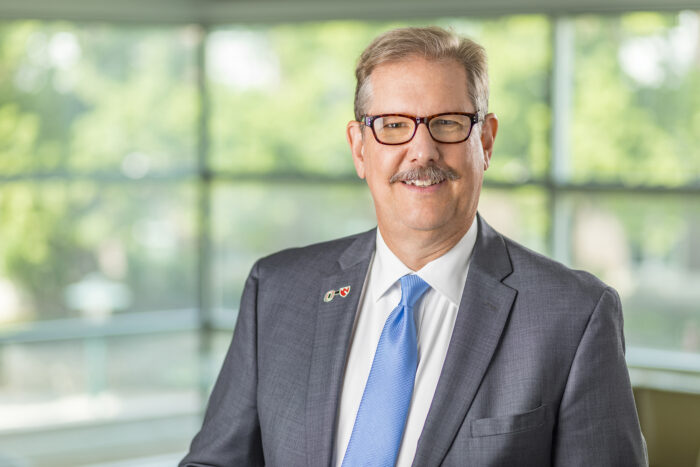
By Melanie Stewart
We all have stress and anxiety, it’s part of being human. Then 2020 happened. Nothing like a worldwide pandemic to change your life and dial up the anxiety levels—working/taking classes from home, social distancing, health issues, not seeing friends/family in person, and it all happened in an election year. Holidays can be stressful anytime, and we’ve never experienced them in a pandemic.
LiveGreen recently starting hearing more people talk about eco-anxiety. Eco-anxiety generally describes chronic/severe anxiety related to humans’ relationship with the environment. In 2017, the American Psychiatric Association (APA) described eco-anxiety as “chronic fear of environmental doom.”
We have talked about the physical health effects and continuing impacts of climate change and the APA noted that it takes a toll on mental health too: “Climate change-induced severe weather and other natural disasters have the most immediate effects on mental health in the form of the trauma and shock due to personal injuries, loss of a loved one, damage to or loss of personal property or even the loss of livelihood.” These changes and the fear that they will happen, understandably, wears on people.
There’s lots of talk about taking care of your physical health, but everyone needs to take care of their mental health too. As such, LiveGreen’s December webinar will feature UNMC’s Dr. Steven Wengel and he will discuss practical tips for managing stress and anxiety now, and as we head into the holidays.
Dr. Wengel is originally from Omaha and attended UNL and UNMC. He completed his psychiatry residency and geriatric psychiatry fellowship training at Creighton University and UNMC. He has been practicing geriatric psychiatry since 1991, and is an active and enthusiastic teacher of students and residents. Dr. Wengel has also served UNMC in several administrative roles, including clerkship director and department chair. In 2018 he became UNMC and UNO’s first Assistant Vice Chancellor for Campus Wellness, and in this role he is developing strategies to reduce stress and burnout in students, staff, faculty, and healthcare professionals. His vision is to improve the physical, psychological, and social wellbeing of all who work and learn in the health care world, the academic environment, and the community at large.
Please join us via zoom on Wednesday, December 2nd from 10-10:30am for this webinar, which is open to the public. If you can’t attend, a recording will be posted on the LiveGreen website.
Please click the link to join the webinar. If asked for a passcode 517371
ORBT Launches
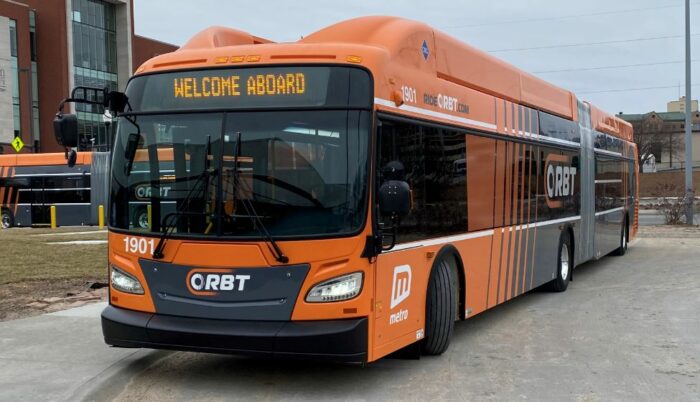
By Melanie Stewart
Omaha’s Bus Rapid Transit (ORBT) will officially launch Wednesday, November 18th! We have written previous blogs on ORBT, as this is a big step forward for Omaha. ORBT is different than other bus routes, here’s the details:
- ORBT stations have canopies, audio/visual real-time arrival announcements, pre-paid boarding, level boarding, and interior bike racks.
- Buses are bigger, more spacious inside, and have 3 doors to speed up stops.
- Most of the day, a new bus will arrive every 10 minutes.
- For the first four months, ORBT will be free for everyone, all the time.
- Will be part of TravelSmart; registered riders receive free rides to and from campus.
- On-board/free Wi-Fi.
- Many ORBT stops have Heartland B-cycle stations to speed up your commute after you get off the bus.
- ORBT will replace Route 2
- Start (downtown) and End (Westroads) are the same.
- Daily round trips will increase from 65 to 100.
- Frequently used stops are the same, but less frequently used stops have been adjusted. However, 94% of riders will have their stop changed by 3 blocks or less.
- Other routes are being adjusted to make better connections with ORBT, including more 92 Express trips to Village Pointe, see MyRideOMA to double-check your route
Drivers are being asked to share the road. You will notice the big, orange buses and the bus-only lanes downtown. Traffic cannot enter those lanes unless they are making a right turn. Watch this short video for details. “Transit Signal Priority” has been installed at intersections west of 30th St., allowing buses to extend green lights and keep them moving. ORBT will also have a que jump at 84th street; the bus will receive a green light first while the rest of traffic waits, allowing them safely merge into, and get ahead of, traffic. Watch this short video to see how it works.
While we’re excited about ORBT’s launch, your safety and controlling COVID transmissions are of the utmost importance. If you are traveling to/from campus and can do so in a more socially distanced manner (walking, biking, carpooling with someone you live with, or driving alone) please do so. If you need the bus to get to work/receive care, please wear a mask, don’t touch your face, social distance as much as possible, wash your hands as soon as you arrive on campus, and know that Metro is working to keep buses clean.
America Recycles Day
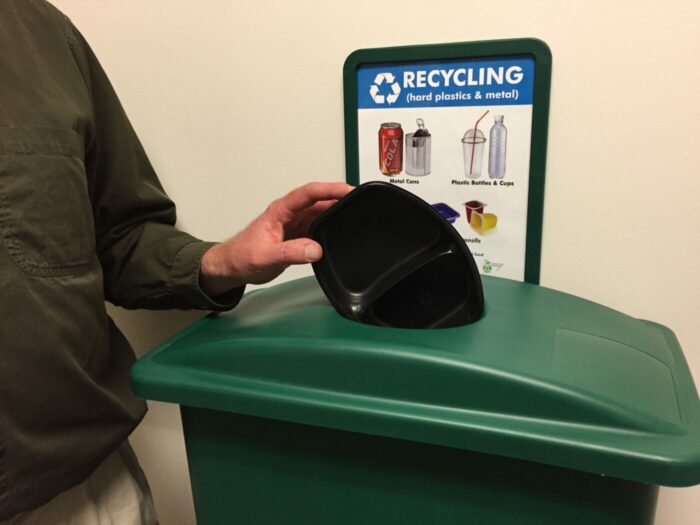
By Melanie Stewart
This Sunday, November 15th, is America Recycles Day, the only nationally recognized day dedicated to promoting the act of recycling, and buying recycled products!
Of all the “Days,” American Recycles Day is the easiest to celebrate because it takes no preparation. If you’re finished using a product and it is recyclable, then put it in the correct recycling bin—that’s all there is to it! Not sure what to recycle on campus? Watch this short video to find out, or visit our recycling page for information. Check out the Wasteline site for recycling information in and around Omaha.
We have already told you how important it is to recycle. You know about the huge impact it can have on our planet, natural resources, and economy. Make sure you recycle right; wish-cycling and/or sorting items incorrectly actually creates more problems and increases waste. Here are some resources from Keep Omaha Beautiful to help you correctly recycle everything possible.
- Recycle Right: Learn what can and cannot be recycled curbside—it’s more than you think!
- Searchable Recycling Charts: Have a specific item to recycle? Find out how, here and here.
- Recycling and Reuse Resources: Divert waste even if it can’t be recycled curbside.
When you go to purchase a product, anything from a pack of paper to packaged food, take a look at the label. If it contains the 3-arrow triangle (often referred to as the recycle symbol) it is recyclable. If that triangle is inside in a circle, that product is made from recycled content. The package should also tell you that it’s made from recycled content, the percentage of that item that was made from recycled materials, and whether or not the materials are “post-consumer content.”
Post-consumer means the material came from the end-user and that material would have otherwise ended up in the landfill, as it had no other value. These are items like pop cans, paper, or plastic that has been used. Pre-consumer/industrial content is still recycled material, but that material was produced during the production of another product. Examples include wood chips, sawdust, and glass or metal shavings.
By purchasing products that have the highest percentage possible of recycled content, you complete the loop and make sure your recycling effort has value. This is an easy step and takes no extra effort at all!
The Med Center is Now a Composting Drop-Off Location

By Melanie Stewart
Food waste happens at all parts of the supply chain: post-harvest waste, items lost in transportation, grocery stores throwing out food, and consumers (us) throwing out food before it’s prepped or what we don’t eat. A major culprit in food waste is confusion regarding what’s OK to eat—“sell by”, “best by”, “use by” and “expires on” dates are not regulated by the FDA and can mean something different, depending on the manufacturer. Generally, those dates are conservative, and when the food is at its peak, not when it goes bad. So how much food is wasted? According to the National Resources Defense Council:
- 40% of the food in the U.S. is never eaten
- That’s 300lbs per person, per year
- The average family of 4 throws away $1800 worth of food each year
- At a total cost of $218 Billion
- While 1 in 8 Americans don’t have enough food to eat (pre-pandemic numbers)
- 90% of us throw food away too soon
- In the landfill, food waste produces harmful methane, accounting for ~11% of worldwide greenhouse gas emissions
A few simple steps can help you save money and prevent food waste. Store food properly and then consider these actions—your wallet and the planet will thank you.
Prevention of waste is always best, but when mistakes happen, there’s composting. You can compost many food items at home, and we have a 3 part article series and a webinar to get you started.
If composting isn’t for you, you don’t have a yard, or you want to compost items that can only be composted commercially (pizza boxes, meat/dairy products, dog poo, etc.) there’s a relatively new option called the Compost Club. Individuals pay (discounts for students/teachers/seniors/veterans/active military) to have the ability to drop off materials to be composted.
We are proud to be one of the drop off locations for Compost Club participants. Compost can be easily dropped off on your way in to work or school in one of the green totes located on the east end of lot 15 (by SLC and MCPH). Numerous other locations are available across the metro area.
Not only do you prevent methane, compost is nutrient-rich and can help store carbon—a win-win! As part of the membership you get compost back to use in your garden, or you can donate it to a community garden.
Think Before You Print
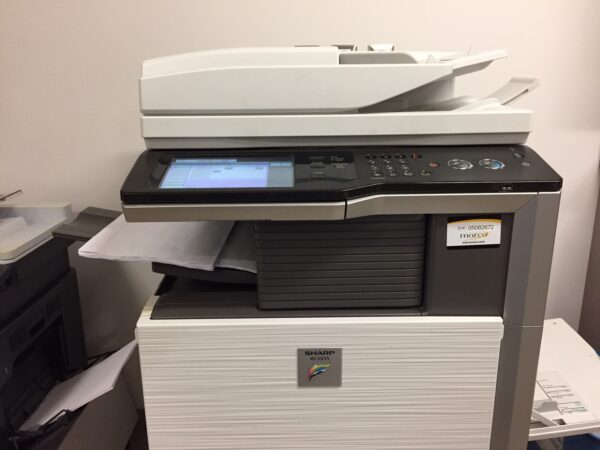
Prior to the pandemic, how much did you print? Now, during the pandemic, how much do you print? With many people working from home, printing has been dramatically reduced. Without printers or a way to send physical documents, we had to find electronic ways to do our jobs.
Printing less didn’t start with the pandemic, it actually started years ago when many “personal printers” were removed from offices in favor of the shared, all-in-one devices. This was largely a cost savings measure—it’s more expensive per print on smaller devices and both UNMC and Nebraska Medicine needed to cut budgets. Removing printers had a positive environmental impact too—less toner cartridges to deal with, less electricity being used, and less printing. Not surprisingly, when people have to print to a shared device that’s not right next to them, they print less.
So just how much paper has been saved? In FY17 UNMC and Nebraska Medicine combined to use a whopping 92,040,000 sheets of paper. We had significant reductions in FY18 and FY19, and with numbers from FY20 just in, we are down to 48,950,000 sheets of paper. In the last three years we have saved a minimum of:
- 62,861,447 sheets of paper
- $379,000 in purchased paper costs
- Does not include labor to deliver, stock, load, transport, or shred; which would be additional savings
- 7,543 trees
- 362,083 lbs of CO2e (164 Metric Tons) which harms human health and is a major contributor to climate change.
Some of FY20’s savings can be attributed to COVID—with more people working from home, we printed less. We may not have had a choice, but we started taking advantage of the different aspects of Office.365 (Teams, OneNote, etc.) and more patients use OneChart, we saw even further reductions.
Now, printing less has another benefit, by limiting exposure to a highly touched, hard to clean items—the printer, mailing envelopes, filing folders, and the paper itself.
Paper purchased (or not purchased!) is factored into the Med Center’s Zero Waste goal. By printing less and reducing paper use, we’re able to advance even further toward our goal of 90% diversion by 2030.
Keep up the good work, and stick to those non-printing habits—don’t start printing if you come back to campus. Still learning? So are we! Here are some resources to help you reducing printing in your area.
Healthy Earth Alliance
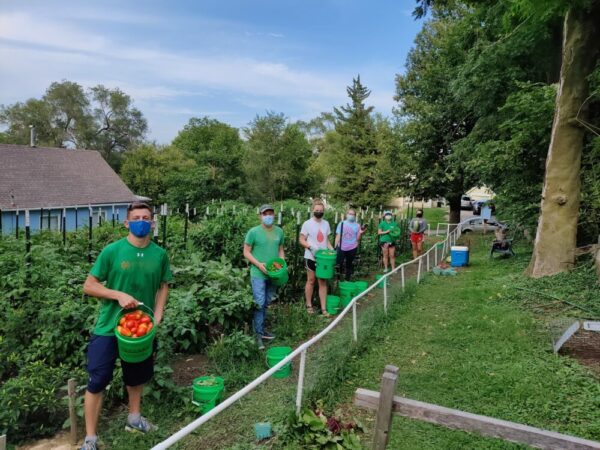
By Chris Dethlefs
Last year several students on campus came together to create a new student interest group: Healthy Earth Alliance (HEAL). These students have a passion for sustainability in health care, renewable energy, reducing waste, and working to improve the health of our community.
This past Earth Day they worked with med students at Creighton to write an op-ed “Let’s flatten the curve on climate change” and also cleaned up litter at Memorial and Elmwood Parks.
They created a Facebook page UNMC Healthy Earth Alliance Buy/Sell/Trade to promote sustainable practices and encourage students to obtain needed/wanted items from peers instead of buying new. Students are transitioning from casual to professional attire while still going to school– so gifting items you no longer want to wear can be a big help.
This summer HEAL students collaborated with an association of patients at OneWorld Community Health Center to support their work at the “Fe y Esperanza” (Faith and Hope) community garden located at 5026 S 19th Street in south Omaha. Students volunteered weekly through July and August to harvest fresh produce that went to OneWorld’s food pantry which is supporting staff and patients during the pandemic. There 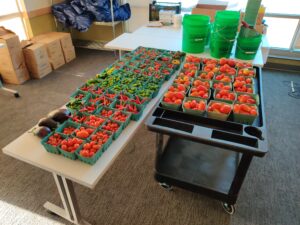 were at least 5 students there each week from the Colleges of Medicine, Public Health, and Allied Health Professions. The group collected an estimated 15-20 gallons of fresh vegetables each week – most of which was gone from the pantry by the next day! This was a fun and safe way for UNMC students from multiple colleges to connect with local food production, have some outdoor social interaction, and support vulnerable communities during these challenging times.
were at least 5 students there each week from the Colleges of Medicine, Public Health, and Allied Health Professions. The group collected an estimated 15-20 gallons of fresh vegetables each week – most of which was gone from the pantry by the next day! This was a fun and safe way for UNMC students from multiple colleges to connect with local food production, have some outdoor social interaction, and support vulnerable communities during these challenging times.
In addition to learning more about climate change’s impact on human health, HEAL is working to incorporate climate change into various curricula at UNMC—making students aware of how a changing climate impacts their future patients. They are also supporting a fossil fuel divestment campaign within the University of Nebraska System, which currently has more than $90million invested in fossil fuels including in companies on the Carbon Underground list. The petition urging leaders to take action can be found here. You do not need to be a University employee, student, or alum to sign.
Free Trees for Fall Planting
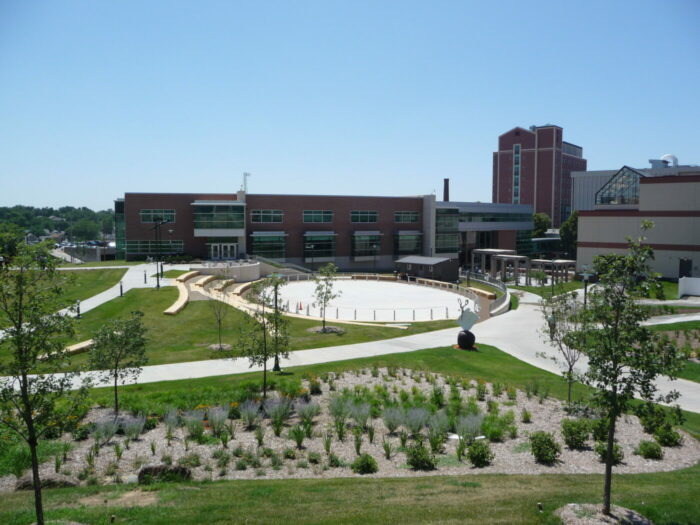
By Blake Van Jacobs
For the second year in a row, the Med Center received a “Free Trees for Fall Planting” grant from a collaborative effort from the Nebraska Forest Service (NFS) and Nebraska Statewide Arboretum (NSA). This year we received three oak trees, one elm tree, and one tulip tree and all were planted the day after we received them. They replaced trees that died or were damaged, and 2 were used in areas that will have trees die off later, at which time the ‘new’ trees will be established and ready to take their place.
This effort from the NFS and NSA set out to plant at least 500 trees within Nebraska this fall in areas that are of civic importance or have a high need for trees. In LiveGreen’s “Health and Urban Trees” article we noted that urban trees provide a canopy that help cool down urban areas. Trees provide numerous environmental benefits including storm-water runoff capture, carbon storage and sequestration, and reducing energy use, all of which positively impacts human health. To that end, the Nature Conservancy and the National Institute of Health began a study in 2017 in Louisville, Kentucky focusing on how nature can better improve human health in urban areas. Planting trees in urban areas and in neighborhoods is not only to beautify the area but provides a valuable, almost priceless, physical and mental health benefit to the community and continuing to plant trees can spur job creation, decrease air pollution, mitigate climate change, and give communities a safer space to live, work, and play.
This grant for businesses and other community organizations exists because fall is actually the best time to plant trees. According to the University of Nebraska Extension office of Community Environment, the soil is warm which encourages new root formation, the air temperatures are below the 90-100 degree summer average temperatures which encourages trees to produce shoots, and on average more moisture would occur than in the spring. According to Bob Henrickson at the NSA, “Plants are less stressed by the heat (in the fall), more likely to develop a strong root system and gardeners will be way ahead of the game next spring.” Fall is also usually the time where garden centers have trees and plants on sale, making fall a great time for you to plant too.
Chilled Beams
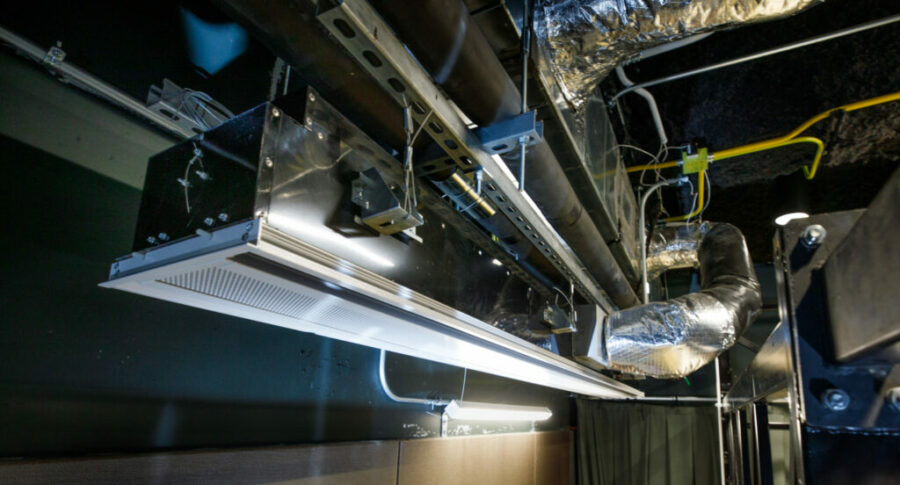
By Melanie Stewart
Earlier this summer we told you about some exciting energy technology that went into the Dr. Edwin G. & Dorothy Balbach Davis Global Center, but we couldn’t fit it into one article, so here’s the second installment.
In 1975, chilled beam technology was first developed in Norway as a more efficient method of temperature control. Starting in the ‘90s, chilled beams could be found over much of Europe and, more recently, in the United States, and these systems have been used successfully in patient rooms since 2013. Now, UNMC/Nebraska Medicine has joined the ranks of institutions such as Harvard, Clemson, and the University of California, Davis Health & Wellness Center taking advantage of this technology’s benefits.
Chilled beams were used in the Davis Global Center as an energy-efficient way to provide temperature and humidity control, but with significantly less forced (blown) air than a conventional building. This technology uses a combination of a small amount of air, coupled with a chilled water coil, to maintain a comfortable environment. A unit above the ceiling dries out the air before it passes over the chilled beams – an important step to avoid condensation. Water coils mounted on the ceiling are chilled, cooling the air around them. The cooled air falls and warmer air rises to make contact with the chilled water coils. Because chilled beams use less forced air, the building and its occupants are able realize the benefits of less noise, no drafts, and higher ceilings in many spaces.
In addition to those benefits, by not having to power fans to force air into spaces, we use less energy (up to 25%) to create the same amount of cooling, and that means cost savings/avoidance and less emissions as well. The Med Center has a net zero building emissions goal to reach by 2030, so increasing efficiency and emitting less is a must. It’s our mission to create a healthy future for all, and that means reducing emissions—which are leading contributors to numerous health issues including, but not limited to, lung ailments, cancer, and fertility issues, not to mention causing climate change.
Campus Sustainability Month
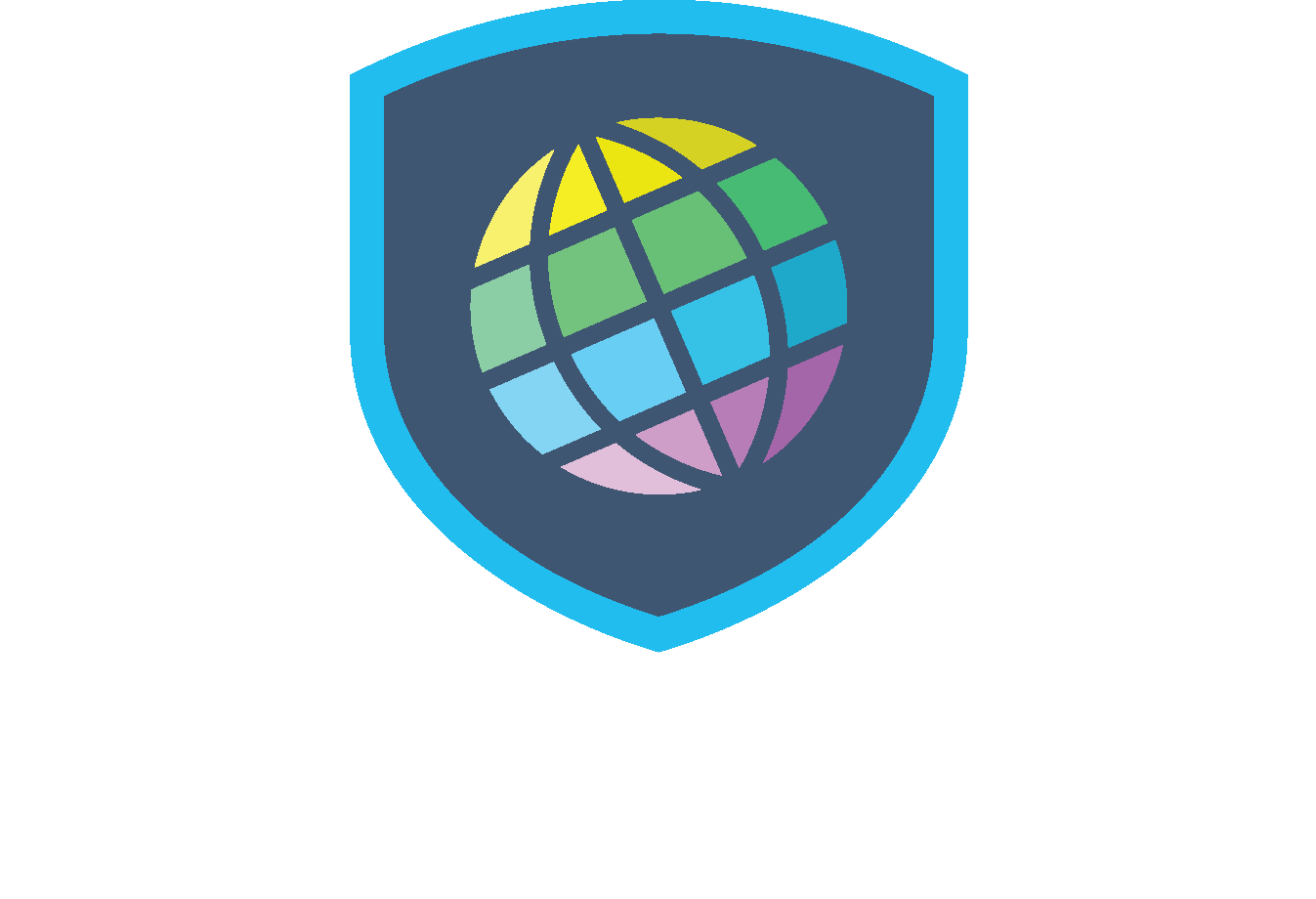
UNMC will join campuses in are celebrating Campus Sustainability Month this October. Hosting Campus Sustainability Month in October is a nice juxtaposition to Earth Month in April, and often serves as a catalyst for student involvement on campus.
Academic campuses are essential drivers to the environmental movement. In large part, Colleges and Universities’ interests in sustainability stem from student interests; UNESCO reports that 91% of students agree that their higher education institution should actively pursue and promote sustainable development. Academic institutions pursuing environmental sustainability and climate change resiliency often partner with their local communities, which has positive effects on not just the campus, but the residents, municipalities and land surrounding the institution as well.
Like everything else, Campus Sustainability Month will look different this year as a result of the COVID-19 pandemic. This year, we would like to invite you to become a LiveGreen Ambassador, where you can join the team that is helping us achieve our 2030 sustainability goals. As an ambassador you:
- Model sustainable behaviors
- Share information and discuss with colleagues
- Help implement sustainability initiatives through personal communication
We can’t reach our goals without you. Trying out the ambassador program with our orientation in October is a great way to learn more about sustainability at the Med Center, and help us transform our system.
We have the following activities planned, and would like to share other opportunities to engage in sustainability more broadly:
- LiveGreen Ambassador Workshop: If you are interested in becoming an ambassador, or already are one, we are hosting a virtual workshop on October 15th. Email LiveGreen for more information.
- People’s EcoChallenge: You can join the Med Center’s team that will compete in the People’s EcoChallenge, a month long virtual challenge (Oct 7th – Oct 28th) where participants pledge and then record a variety of sustainable activities. Friends and family are welcome too!
- CleanMed – Cleanmed is a conference run by two non-profit organizations designed to explore environmental sustainability in the healthcare sector. Traditionally, these conferences have a cost to attend, but this year, CleanMed is hosting six, free, virtual sessions on sustainability in healthcare. Register for the virtual sessions, and join us for discussion circles following.
CleanMed Sessions in October:
- October 7th: Resilience from farm to plate
- Oct 14th: Rethinking supply chains in response to COVID-19
- Oct 21st: Collaborating to build resilient health care
- Oct 29th: Clinical Sustainability: Environmental Stewardship at the Bedside
